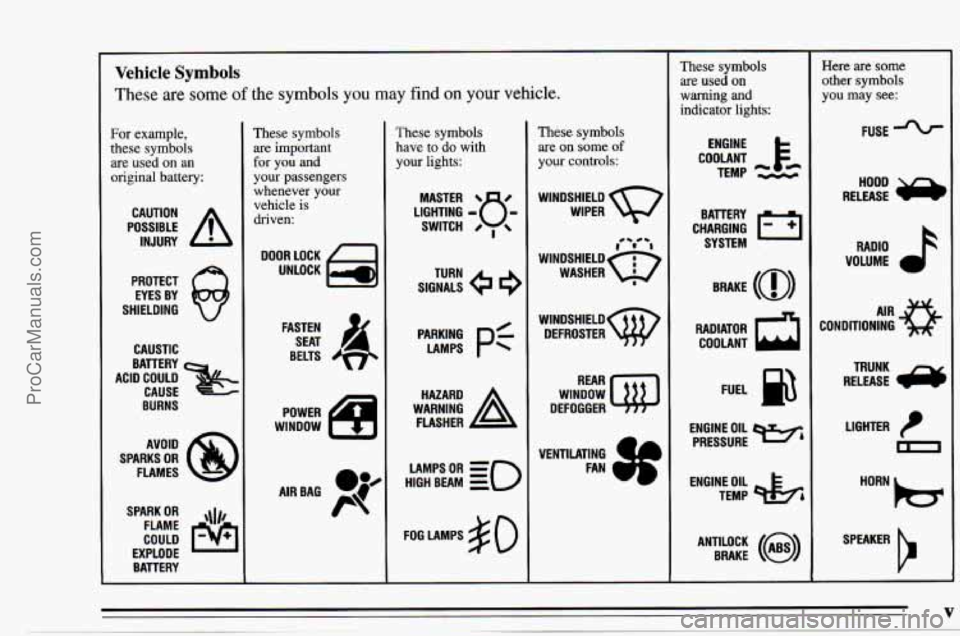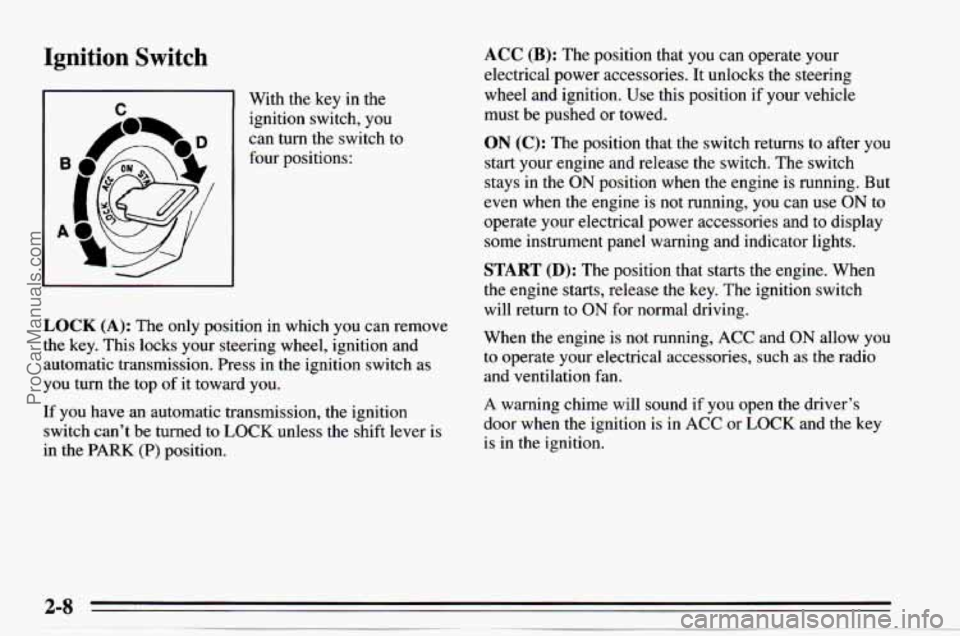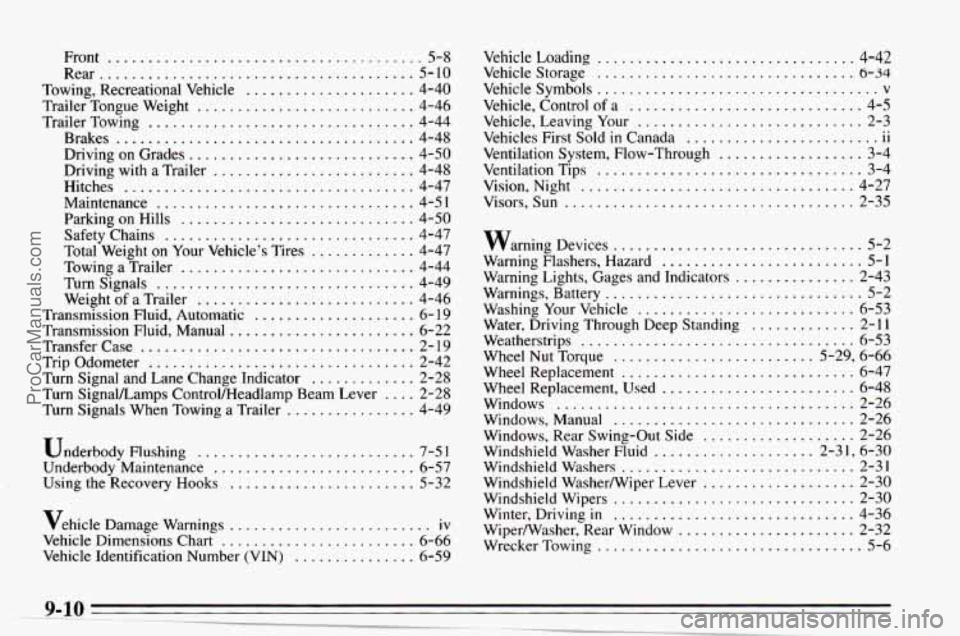1995 CHEVROLET TRACKER warning lights
[x] Cancel search: warning lightsPage 6 of 354

~~ Vehicle Symbols
These are some of the symbols you may find on your vehicle.
For example,
these symbols
are used on an
original battery:
POSSIBLE A
CAUTION
INJURY
PROTECT EYES BY
SHIELDING
CAUSTIC
ACID COULD BATTERY
CAUSE
BURNS
SPARK
OR ,\(I,
COULD FLAME
EXPLODE BAVERY
These symbols are important
for
you and
your passengers
whenever your
vehicle
is
driven:
DOOR LOCK
UNLOCK
FASTEN SEAT
&,
BELTS
POWER
WINDOW
LR
AIRBAG P@K
These symbols
have to
do with
your
lights:
SIGNALS e
TURN
PyN;
pf
WARNING A
HAZARD
FLASHER
HIGH
LAMPSoR BEAM = =o
FOG LAMPS $0
These symbols
are on some of
your controls:
WINDSHIELD
WIPER
,-/ 'I
WINDSHIELDQ
WASHER 8
wlNDSHIELDw DEFROSTER
WINDOW
DEFOGGER
These symbols are used on
warning and
indicator lights:
COOLANT F-
TEMP --
ENGINE
CHARGING
I-1
BATTERY SYSTEM
BRAKE
(a)
RADIATOR a
COOLANT
FUEL
ENGINE OIL
e,
PRESSURE
TEMP
OIL pk;
ANTIU)CK BRAKE (i)
~
Here are some
other symbols
you may see:
FUSE -%-
RADIO h
VOLUME a
CONDITIONING AIR 43
LIGHTER
m
SPEAKER
b
V
. ~ ProCarManuals.com
Page 51 of 354

Ignition Switch
I n 1 With the key in the
ignition switch, you
can turn the switch to
four positions:
I I
LOCK (A): The only position in which you can remove
the key. This locks your steering wheel, ignition and
automatic transmission. Press in the ignition switch as
you turn the top
of it toward you.
If you have an automatic transmission, the ignition
switch can't be turned
to LOCK unless the shift lever is
in the
PARK (P) position.
ACC (B): The position that you can operate your
electrical power accessories.
It unlocks the steering
wheel and ignition. Use this position if
your vehicle
must be pushed
or towed.
ON (C): The position that the switch returns to after you
start your engine and release the switch. The switch
stays in the
ON position when the engine is running. But
even when the engine is not running, you can use
ON to
operate your electrical power accessories and to display
some instrument panel warning and indicator lights.
START (D): The position that starts the engine. When
the engine starts, release the key. The ignition switch
will return to
ON for normal driving.
When the engine is not running,
ACC and ON allow you
to operate your electrical accessories, such as the radio
and ventilation fan.
A warning chime will sound if you open the driver's
door when the ignition is in
ACC or LOCK and the key
is in the ignition.
ProCarManuals.com
Page 86 of 354

Warning Lights, Gages and Indicators
This part describes the warning lights and gages that
may be on your vehicle. The pictures will help you
locate them.
Warning lights and gages can signal that something is
wrong before it becomes serious enough to cause an
expensive repair or replacement. Paying attention to
your warning lights and gages could also save you or
others from injury.
Warning lights come on when there may be or is
a
problem with one of your vehicle’s functions. As you
will see in the details on the next few pages, some
warning lights come on briefly when you start the
engine just to let you know they’re working. If you are
familiar with this
section, you should not be alarmed
when this happens. Gages
can indicate when there may be or is a problem
with one of your vehicle’s functions. Often gages and
warning lights work together to let you
know when
there’s a problem with your vehicle.
When one of the warning lights comes on and stays on
when you are driving, or
when one of the gages shows
there may be a problem, check the section that tells you
what to do about it. Please follow this manual’s advice.
Waiting to do repairs can be costly
-- and even
dangerous.
So please get to know your warning lights
and gages. They’re a big help.
ProCarManuals.com
Page 236 of 354

Front Axle Engine Coolant
When to Check and Change Lubricant
Refer to the Maintenance Schedule to determine how
often to check the lubricant and when to change it. See
“Periodic Maintenance Inspections” and “Scheduled
Maintenance Services” in the Index.
How to Check Lubricant
If the level is below the bottom of the filler plug hole,
you’ll need to add some lubricant.
If the differential is at operating temperature (warm),
add enough lubricant to raise the level to the bottom of
the filler plug hole.
If the differential is cold, add enough lubricant to raise
the level to 1/2 inch (12 mm) below the filler plug hole.
What to Use
Refer to the Maintenance Schedule to determine what
kind of lubricant to use. See “Recommended Fluids and
Lubricants” in the Index. The following explains
your cooling
system and how to
add coolant when it is low. If you have a problem with
engine overheating, see “Engine Overheating’’ in the
Index.
The proper coolant for your Geo will:
0 Give freezing protection down to -33°F (-36°C).
Give boiling protection up to 258°F (125°C).
Protect against rust and corrosion.
Help keep the proper engine temperature.
Let the warning lights work as they should.
What to Use
Use a mixture of one-half clean water (preferably
distilled) and one-half antifreeze that meets
“GM
Specification 1825M,” which won’t damage aluminum
parts. You can also use a recycled coolant conforming to
GM Specification 1825M with a complete coolant flush
and refill. If you use this mixture, you don’t need to add
anything else.
ProCarManuals.com
Page 274 of 354

7 8
9
10 11
12
13
14 Lighter;
Radio
Ignition System; Warning and Indicator Lights
Turn Signal Lamps; Back-up Lamps
WiperNasher
Rear Defogger
Heater
Rear Wheel Anti-Lock Main Relay
Electronic Fuel Injection Main Relay Replacement Bulbs
Back-up .................................... 1156
Center High-Mounted Stop
...................... 921
Dome
............ GM Part No. 9605 1559 or equivalent
Front Parking and Turn Signal
............... 1157 NA
Headlamp (Halogen) .......................... 9004
GM Part
No. 944173 1 or equivalent
GM Part
No. 96052599 or equivalent
Heater
or Air
Conditioning Control ...................
Indicator and Warning
Brake
........... GM Part No. 9433184 or equivalent
Check Engine
..... GM Part No. 9433184 or equivalent
4WD ........... GM Part No. 9433184 or equivalent
................ GM Part No. 9433184 or equivalent
Safety Belt
....... GM Part No. 9433184 or equivalent
Turn Signal
...... GM Part No. 9433 184 or equivalent
Charging System
. . GM Part No. 9433184
or equivalent
Engine Oil Pressure GM Part
No. 9433184 or equivalent
Headlamp High Beam
Instrument Cluster GM Part
No. 9605 1561 or equivalent
6-63
ProCarManuals.com
Page 349 of 354

Temperature Control ........................... 3-2
Brake System Warning
........................ 2-45
Charging System
............................. 2-44
Check Engine
............................... 2-46
Engine Oil Pressure
.......................... 2-47
Safety Belt Reminder
..................... 1-9. 2-44
Lighter. Cigarette
............................... 2-36
Loading Your Vehicle
........................... 4-42
Lights
Daytime Running Lamps
(DRL) Indicator ......... 2-49
Loading Your Vehicle
for Off-Road Driving .......... 4-14
Locks Door
....................................... 2-2
Steering Column
............................. 7-50
Tailgate
..................................... 2-4
Torque
..................................... 2-22
Long Trip. Before Leaving on a
.................... 4-33
Loss of Control
................................ 4-12
Low
(L) Position. Automatic Transmission ........... 2- 14
Lowering and Raising the Canvas Top
.............. 2-56
Lubrication. Body
.............................. 7-49
Main Fuse Block
.............................. 6-62
Maintenance Record
............................ 7-56
Maintenance Schedule
............................ 7- 1
Owner Checks and Services .................... 7-48
Periodic Maintenance Inspections
............... 7-52
Recommended Fluids and Lubricants
............ 7-54
Schedule1
................................... 7-8
Schedule
I Definition .......................... 7-4
ScheduleII
................................. 7-33
Schedule
11 Definition .......................... 7-6 Scheduled Maintenance Services
................. 7-2
Maintenance. Underbody
......................... 6-57
Maintenance. When Trailer Towing
................. 4-51
Malfunction Indicator Lamp (Check Engine Light)
.... 2-46
Manual Front Seat
............................... 1-1
Manual Remote Control Mirror Manual Transmission
............................ 2-14
Fifth (5) Position
............................. 2-15
First (1) Position
............................. 2-14
Fourth (4) Position
........................... 2-15
Neutral
(N) Position .......................... 2-15
Parking Your Vehicle
......................... 2-24
Reverse (R) Position
.......................... 2-15
Second
(2) Position ........................... 2-15
Shiftspeeds
................................ 2-16
Starting Your Engine
........................... 2-9
Third (3) Position
............................ 2-15
Manual Transmission Fluid
....................... 6-22
Adding
.................................... 6-23
Checking
................................... 6-22
ManualWindows
............................... 2-26
Methanol (In
Fuel) ............................... 6-3
Mirrors
....................................... 2-34
Convex Outside
............................. 2-35
Inside Rearview
............................. 2-34
Outside Manual Adjust
........................ 2-34
MTBE (In Fuel)
................................. 6-3
Neutral
(N) Position, Automatic Transmission ....... 2-13
Neutral (N) Position, Manual Transmission
.......... 2-15
New Vehicle “Break-In”
.......................... 2-7
Nightvision
................................... 4-27
9-6
ProCarManuals.com
Page 353 of 354

Front ....................................... 5-8
Rear ....................................... 5-10
Towing. Recreational Vehicle ..................... 4-40
Trailer Tongue Weight ........................... 4-46
Trailer Towing
................................. 4-44
Brakes
..................................... 4-48
Driving on Grades
............................ 4-50
Driving with a Trailer
......................... 4-48
Hitches
.................................... 4-47
Maintenance
................................ 4-51
Parking on Hills
............................. 4-50
Safety Chains
............................... 4-47
Turn Signals ................................ 4-49
Total Weight
on Your Vehicle’s Tires ............. 4-47
Towing a Trailer
............................. 4-44
Weight
of a Trailer ........................... 4-46
Transmission Fluid. Automatic
.................... 6- 19
Transmission Fluid. Manual ....................... 6-22
Transfer Case
.................................. 2- 19
Turn Signal and Lane Change Indicator ............. 2-28
Turn SignalLamps Control/Headlamp Beam Lever
.... 2-28
Turn Signals When Towing a Trailer
................ 4-49
Trip Odometer
................................. 2-42
Underbody Flushing
........................... 7-5 1
Underbody Maintenance ......................... 6-57
Using the Recovery
Hooks ....................... 5-32
Vehicle Damage Warnings
......................... iv
Vehicle Dimensions Chart ........................ 6-66
Vehicle Identification Number
(VIN) ............... 6-59
Vehicle Loading ................................ 4-42
Vehicle Storage ................................ 6-34
Vehicle Symbols ................................... v
Vehicle. Control of a ............................. 4-5
Vehicle. Leaving Your
............................ 2-3
Vehicles First Sold
in Canada 11
Ventilation System. Flow-Through .................. 3-4
Ventilation Tips
................................. 3-4
Vision. Night
.................................. 4-27
Visors. Sun
.................................... 2-35
.. ........................
warning Devices ............................... 5-2
Warning Lights. Gages and Indicators
............... 2-43
Washing Your Vehicle
........................... 6-53
Water. Driving Through Deep Standing ............. 2-11
Wheel
Nut Torque ......................... 5-29. 6-66
Wheel Replacement
............................. 6-47
Wheel Replacement. Used
........................ 6-48
Windows
..................................... 2-26
Windows. Manual
.............................. 2-26
Windows. Rear Swing-Out Side
................... 2-26
Windshield Washer Fluid
.................... 2-3 1. 6-30
Windshield Washers ............................. 2-31
Windshield WasherlWiper Lever
................... 2-30
Windshield Wipers
.............................. 2-30
Winter. Driving
in .............................. 4-36
WiperNasher. Rear Window
...................... 2-32
Warning Flashers. Hazard
......................... 5-1
Warnings. Battery ................................ 5-2
Weatherstrips
.................................. 6-53
WreckerTowing
................................. 5-6
9-10 .. ~ .. . .. ---~‘-.”.‘- ^1 ___.-___-__ ProCarManuals.com